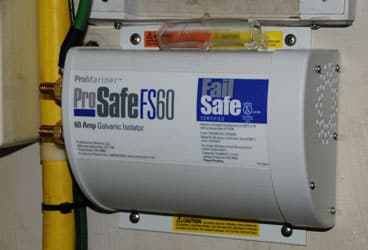
galvanic isolator
Have you ever heard of a “hot” marina? According to dockside lore, these are marinas where your zincs, shaft, prop, and through-hulls are in danger of rapid consumption or corrosion, presumably due to leaking AC and DC current coursing through the water and around docked boats.
In fact, the term “hot marina” can be tough to define, as any marina with shore-power hookups may produce corrosion issues, though the corrosion is nearly always a result of other vessels, not the marina’s facilities. That said, it’s very possible that you’ve visited marinas or docks where your zinc anodes were rapidly consumed, followed by the corroding of your boat’s underwater metals.
When it comes to corrosion, there’s no shortage of misunderstanding, particularly about the role that shore power plays. With very rare exceptions, 120- and 240-volt AC shore power doesn’t rapidly consume or corrode zinc anodes or underwater metals; corrosion is primarily a DC phenomenon. However, the shore-power cord, with its green safety ground wire, often plays an accessory role.
Here’s how it works: As soon as you plug your shore-power cord into the dock pedestal—before you’ve switched on anything—you’ve connected your boat and all of its grounded underwater metals, zinc anodes, seacocks, shaft, strut, and so on to the dock’s AC safety ground and, theoretically, to every other boat in the marina and all of their underwater metals. Such an arrangement can wreak havoc with the consumption rates of zinc anodes and the corrosion of underwater metals. Say, for instance, that the owner of the vessel in the slip next to you hasn’t replaced his or her zinc anodes in a year, but you dutifully have: Your anodes will protect both vessels, or even several vessels, until they’re depleted, which is likely to happen very rapidly.
You may wonder if doing away with the green wire and its connection to adjacent boats is the solution. The short answer is an emphatic No. That connection must exist in order to carry fault current back to its source, typically a transformer at the head of the dock.
It’s worth repeating: The green safety ground connection between your vessel and the dock and on to the transformer not only must remain in place but also must be sound and free of corrosion (often found at the cord’s plugs and receptacles) and of excess resistance. Without it, there’s no reliable, safe, and low-resistance path for fault current to return to its source, which in turn will, we hope, trip a circuit breaker or fuse.
However, an alternative option exists: a galvanic isolator. This device is inserted in line with the green safety ground as it enters your vessel, typically between the shore-power inlet and the electrical panel. Its simple mission is to allow AC fault current to pass unimpeded while blocking, to a degree, DC current. With this approach, AC faults are safely conveyed back to their source while destructive galvanic DC current is hindered. With a galvanic isolator in place, your zinc anodes protect your underwater metals and not those of other vessels, thus eliminating any fears of “hot marinas.”
Be sure the galvanic isolator you choose carries a UL Marine rating, is designed to be fail-safe (which means that if it fails, it continues to provide a safe path to ground for fault current), and is compliant with the latest revision of American Boat & Yacht Council Standards, Section A-28 (July, 2008).
Steve D’Antonio offers services for boat owners and buyers through Steve D’Antonio Marine Consulting (www.stevedmarineconsulting.com).
Find more Monthly Maintenance articles here.








